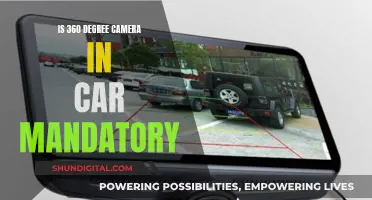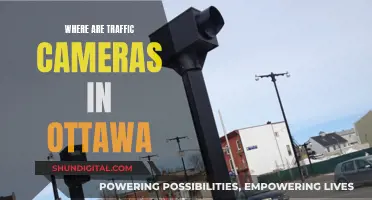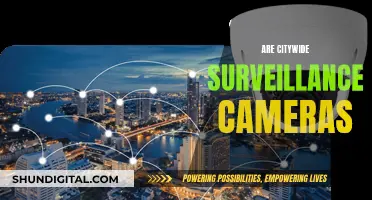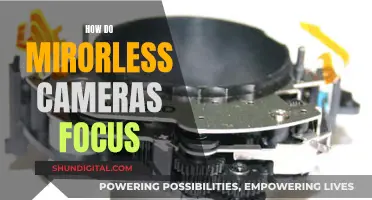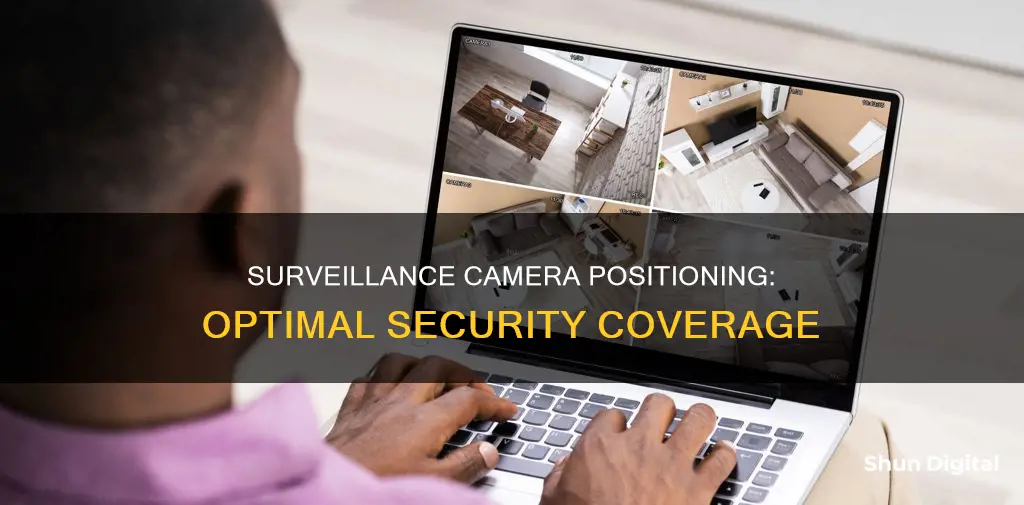
Positioning security cameras correctly is crucial to ensuring optimal protection for your home or business. The effectiveness of surveillance systems relies heavily on the positioning of cameras, as this determines what footage they capture. When deciding where to place security cameras, it is essential to consider the most vulnerable areas of a building and the most likely entry points for intruders.
For homes, security cameras should be placed at obvious points of entry, including ground-floor doors and windows, particularly the main entryway and any side or back doors. Around 34% of burglars enter through the front door, while 22% enter through the back. Cameras should also be placed in areas that contain valuable items, such as the main hallway, living room, or kitchen. Garages, driveways, and yards are other important locations for security cameras, as these areas provide intruders with easy access to tools, vehicles, and other valuables.
To avoid blind spots, it is recommended to place cameras at a height of around 7 to 10 feet and to use multiple cameras to cover a large area. Additionally, it is important to ensure that cameras are durable, protected from the elements, and positioned to avoid issues with lighting, glare, and reflection.
| Characteristics | Values |
|---|---|
| Camera height | 7-10 ft. off the ground |
| Camera angle | Pointed down at an angle |
| Camera placement | Front door, back door, side doors, driveway, yard, second floor, basement, garage, off-street windows, main stairs/hallway, common areas |
| Camera type | Outdoor, indoor, doorbell, PTZ, 4K, PoE, wireless, wired, wide-angle, fixed view, zoom lens, infrared, night vision |
| Camera durability | Robust design, weather-resistant, suitable temperature range |
| Camera reflection and glare | High Dynamic Range (HDR) |
| Camera number | Depends on Wi-Fi speed and security goals |
| Camera proximity to valuables | Within 30-40 ft. horizontally |
| Camera accessibility | Out of reach of criminals |
| Camera power source | Wired, reliable battery, Power over Ethernet (PoE) |
What You'll Learn

Front door
Positioning a security camera at your front door is a great way to deter burglars and increase your home's security. Here are some tips on how to position a surveillance camera at your front door effectively:
- Ideal Height and Angle: It is recommended to place the camera about 7 to 10 feet up, pointing downwards at an angle. This height ensures that the camera is out of reach and provides an optimal view for recording facial images.
- Consider the Surroundings: The placement of the camera depends on the layout of your front entrance. If you have a narrow walkway leading to the door, placing the camera directly above the door should provide sufficient coverage. If you have a larger front porch or an adjacent window, consider installing multiple cameras or positioning the camera in a corner to capture a full view of the area.
- Focus Range: Ensure that the camera's focus range covers the desired area. Most cameras have a focus range of 45 to 75 degrees, while wide-angle lenses offer a wider range of 75 to 180 degrees.
- Lighting and Glare: Consider the lighting conditions, especially during the night. Look for cameras with a high IR (infrared) filter or opt for thermal cameras that perform well in low-light conditions. Avoid positioning the camera towards the sun or strong light sources to prevent glare from affecting the image quality.
- Disguise and Secure the Camera: Consider disguising your camera to minimize detection. Additionally, ensure that the camera is securely mounted and out of reach to prevent potential vandals or burglars from tampering with it.
- Regular Maintenance: Regularly check and maintain your camera to ensure it is functioning properly. Keep the lens clean and free from dirt, pollen, or debris that could obstruct the view.
Fujifilm Camera Not Charging: Troubleshooting Guide
You may want to see also

Back door
The back door is one of the most important areas to cover with a security camera. It is the second most popular point of entry for burglars, with 22% of break-ins occurring through this entrance. Therefore, it is recommended to place a camera at the back door to capture anyone entering or exiting the property. If there is a window adjacent to the door, position the camera so that it covers both. Alternatively, have one camera covering the back door and another at the window.
When positioning a camera at the back door, it is important to consider the height and angle. Cameras should be placed at least 7 to 9 feet off the ground, pointing downward at an angle to record facial images. This positioning also makes it more difficult for potential intruders to disable or vandalise the camera. Ensure the camera is securely mounted and consider using a protective casing.
In addition to the back door, it is advisable to place cameras at other entry points, such as the front door and side doors. Covering all ground-floor windows and doors provides the best starting point and will protect the most critical areas. It is also beneficial to install cameras in the front and back yards, providing an early warning if someone is approaching the house.
Focusing Your DJI Spark: The Go4 Way
You may want to see also

Off-street windows
Positioning of Cameras
Place cameras above off-street windows, ideally about 9 feet above the ground. This height ensures that the camera is out of reach and not easily tampered with or destroyed. If installing exterior cameras, a second-floor height is often recommended, provided the camera can still capture clear footage of the windows.
Angle of Cameras
When positioning cameras, ensure they are angled correctly to capture the necessary footage. Avoid placing cameras directly above windows, as this may only capture the top of an intruder's head. Instead, place them a foot or two next to the window, angling them down towards it.
Indoor vs. Outdoor Cameras
You can choose to place cameras outdoors above the windows or use indoor cameras facing towards the windows. Indoor cameras can be effective, but it is important to consider the potential for window glare and other issues that may impact the footage quality.
Camera Features
When selecting cameras for off-street windows, consider choosing cameras with features such as wide-dynamic-range (WDR) capabilities, especially if the windows are in a sunny or mirrored space. WDR cameras can minimize the effects of glare and provide clearer footage. Additionally, consider the field of view (FoV) of the camera. Select a camera with the appropriate lens to capture the desired area effectively.
Lighting Conditions
Ensure that the area around the off-street windows is well-lit to enhance the quality of the camera footage, especially at night. If using non-night vision cameras, provide ample lighting to ensure clear footage, but avoid placing cameras too close to bright lights, as this can disrupt the picture.
Legal Considerations
Remember to respect your neighbour's privacy when positioning cameras near off-street windows. Avoid placing cameras in a way that captures footage of your neighbour's property, including their windows. Comply with local laws and regulations regarding CCTV surveillance and privacy.
Cleaning Surveillance Cameras: A Step-by-Step Guide
You may want to see also

Driveway
Positioning security cameras in your driveway is a great way to monitor people coming and going, deter car thieves, and prevent home break-ins. Here are some tips for installing security cameras in your driveway:
Choose the Right Type of Camera:
- Opt for a waterproof camera with a high IP rating to withstand harsh weather conditions.
- Select a camera with long-range night vision to capture clear images even in low-light conditions or darkness.
- Consider a camera with a high definition of at least 2MP for crystal-clear images, especially if you have a long driveway.
- If your driveway has no internet or power supply, consider a 4G security camera or a complete security camera system that connects to a video storage device.
Positioning the Camera:
- Place the camera in a position that monitors the entire length of your driveway.
- Mount the camera at a height of around 8 to 10 feet to prevent tampering and ensure optimal video quality.
- Consider placing the camera above the front door or a window to cover vulnerable areas and avoid potential vandalism.
- Ensure the camera is securely mounted to a wall or ceiling and is out of reach for intruders.
- If you have a long driveway, you may need to add an Ethernet extension cable to connect the camera to your router.
Additional Considerations:
- Check your state's laws regarding surveillance to ensure you comply with privacy regulations.
- Consider adding a floodlight or spotlight to illuminate intruders and scare them off.
- Test the camera's position before mounting it to ensure it connects to your mobile app and has no blind spots.
- Regularly clean the camera lens to maintain clear footage, especially if it is exposed to dirt or pollen.
Focusing the Mobius Camera: Tips and Tricks
You may want to see also

Yard
Positioning security cameras in your yard is a strategic step towards creating a robust surveillance system for your home. Here are some tips and best practices for installing security cameras in your yard:
- Height and Angle: It is recommended to place cameras at a height of around 7 to 10 feet. This height captures facial images and makes it difficult for intruders to tamper with the camera. Position the camera pointing downward at an angle to capture the best footage.
- Lighting: Avoid pointing cameras directly at the sun or strong light sources as this can cause glare and high contrast in your footage. Consider the movement of the sun and angle your cameras to receive indirect light.
- Protection from Elements: Choose cameras that are weather-resistant and suitable for outdoor conditions. Place them under eaves or semi-protected areas to shield them from harsh weather conditions.
- Avoid Obstructions: Install cameras away from branches, bushes, or plants that can grow over time and obstruct the camera's view.
- Visibility: Visible cameras can act as a deterrent against theft. Consider placing cameras in locations where they are noticeable to potential intruders.
- Wide-Angle View: Opt for cameras with a wide field of view to monitor a larger area, especially if you want to capture footage of your entire yard.
- Power Source: Consider the power source when installing outdoor cameras. Battery-powered cameras offer more flexibility in placement, while wired cameras need to be close to a power source.
- Multiple Cameras: Depending on the size of your yard and the number of entrances, you may need multiple cameras to ensure complete coverage. Place cameras at all entrances, including side doors and back doors, to capture anyone trying to enter your property.
- Driveway and Garage: Monitor your driveway and garage to protect your vehicles and equipment from theft or vandalism. A camera pointed at the driveway and garage will help you keep an eye on these areas.
- Windows: If you have first-floor windows that are hidden from street view or face away from the street, consider placing cameras to monitor these areas. Intruders often target these windows as they are less likely to be seen by neighbours or passers-by.
Charging Vintage Camera Gear: 1990s Battery Revival
You may want to see also
Frequently asked questions
The most important areas to cover with your home security cameras are all first-floor doors and windows. As for the height, the camera should be placed at least 7-10 ft off the ground. This will provide the most area coverage and make it harder for criminals to disable or steal the camera.
Yes, avoid placing cameras that capture footage on your neighbour's property. Check your state's laws regarding surveillance to ensure compliance and to respect your neighbour's privacy.
Cameras should be placed in areas with likely targets for thieves, such as hallways, basements, living rooms, and kitchens. Avoid placing cameras in bedrooms and bathrooms as these are private spaces where individuals expect a high level of privacy.



